by Winding Pathways | May 30, 2019 | (Sub)Urban Homesteading, Flowers/Grasses, Garden/Yard, Garden/Yard, Nature, Trees/Shrubs
Enjoying a Welcoming Yard
On the evening of May 17th, one of nature’s brightest colors greeted us at Winding Pathways. It was a brilliant male scarlet tanager, a somewhat rare bird that we only see briefly each May.
The next morning, he was joined by a female, and we assume they’ll nest in Faulkes Heritage Woods that adjoins our property. Tanagers are birds of the big woods, and they’ll find comfortable lodging in the big oaks nearby.
We bought Winding Pathways ten years ago partly because it adjoins the 110-acre Woods protected from development by a conservation easement. It’s mostly steep land that drops down to Indian Creek about a quarter of a mile from our home.
Creating a Welcoming Yard
Since we bought our land, we’ve diversified the yard by restoring prairies and increasing the variety of savanna and woodland wildflowers in shady areas, used prescribed fire to reduce exotics, and installed many birdhouses and feeders. Thanks to the nearby woods and our more open prairie yard with the savanna in between, we enjoy a rich array of bird species. Some, like woodpeckers and chickadees, stay around all year but more migrate to nest here or stop by on their trek to nest further north. We keep a running list of the birds we see from our dining room table each spring. Some we just see winging over but many stop to eat and rest.
-
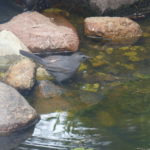
-
Catbird by water
-
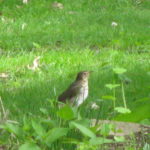
-
The Swainson’s Thrush moves through in the spring.
-
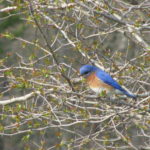
-
Bluebird in tree
Growing Bird List
We’re adding to this list daily but here’s what we’ve spotted and heard so far in May 2019:
Great Blue Heron, Barred and Horned Owl, Canada Goose, Black Capped Chickadee, Tufted Titmouse, Cardinal, White and Red Breasted Nuthatch, Downy, Hairy, Red Bellied, Red Headed, and Pileated Woodpeckers and Flicker, Turkey Vulture, House Sparrow, Wild Turkey, Red Breasted Grosbeak, Northern Oriole, Wood Duck, Common Yellowthroat, Indigo Bunting, Yellow Warbler, Louisiana Waterthrush, Blackpoll Warbler, Yellow Rumped Warbler, Scarlet Tanager, Eastern Kingbird, Phoebe, Great Crested Flycatcher, Cooper’s Hawk, Bald Eagle, Cowbird, House Sparrow, Starling, House and Carolina Wren, House Finch, Red Tail Hawk, Cooper’s Hawk, Crow, Pelican.
-
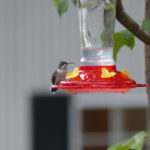
-
A hummer at the feeder.
-
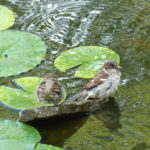
-
A water source helps attract birds.
-
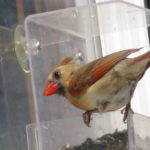
-
Female Cardinal at window feeder.
And the list keeps growing. You, too, can create a welcoming yard. This introductory YouTube video from Canada gives a quick overview of the important elements in attracting birds to a yard. It’s totally “Homegrown” and short. You can create welcoming space on a condominium patio, at a retirement or nursing home, an urban lot or spacious acreage.
Another YouTube video explains how to bring natural elements together to create natural areas. In this case, a “forest.” Again, from large scale to small we can all do this! We would, naturally, adapt to our region of the country and world. The concepts are similar.
What to Consider When Creating a Welcoming Yard
How much time/money do you want to invest?
Do you want to create a naturalistic landscape with native plants?
Do you want to harvest food from the space?
Are your neighbors tolerant of change?
What local codes affect what you want to do? (Ordinances or Covenants)
How prevalent are deer in the neighborhood?
How long do you plan to live in the home?
-
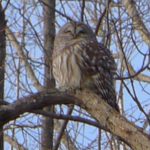
-
Waiting
-
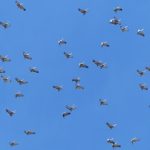
-
Wheeling overhead
-
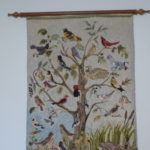
-
A hooked rug by Yvonne Fellows
We’re lucky to have Indian Creek and Faulkes Heritage Woods near Winding Pathways, but even yards not adjacent to natural areas can increase bird variety by creating diverse habitat. Spring is the best season to plant prairies and shrubs! Learn more about birds, their habits and habitats at the Cornell Laboratory of Ornithology.
-
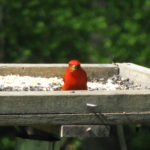
-
Extra nutrition at the feeder.
-
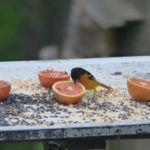
-
A male northern oriole
-
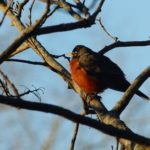
-
A robin surveys the area
by Winding Pathways | Aug 2, 2018 | Garden/Yard, Nature, Pests
Mugging Barberry
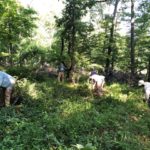
It’s a tough task eradicating Barberry.
One pleasant Saturday morning a couple dozen heavily armed people walked to the interior of Faulkes Heritage Woods. Their weapons were those used to help heal the forest and included thick leather gloves, lopping shears, hand saws, and clippers. They were out to defeat Japanese Barberry.
For two hours they attacked a huge patch of Japanese Barberry that had infiltrated the Woods. Grasping small ones with both hands people yanked them from the soil, shook them off and placed them so the roots would dry out and not re-root. In winter, when the Barberry has berries, the plants are placed on tarps and hauled off so the berries do not drop and root. Ones too big to pull were cut off at ground level.
Volunteers were organized by the Iowa Natural Heritage Foundation. It holds a conservation easement on the property that’s owned by the Marion City Parks Department. Park staff helped, and so did a crew of young people enrolled in AmeriCorps. Various local volunteers pulled and cut.
In Its Native Habitat, It is OK.
Just why is Japanese Barberry such an onerous plant? Actually, it’s a fine shrub in Japan and other parts of Asia where it’s native. There it has natural forces that keep its density in check. It was brought to North America as a landscaping plant because barberry is easy to propagate and transplant. It thrives in many locations, including compacted soil of building sites. It is an ideal landscape plant with one terrible trait.
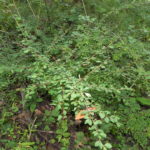
Barberry creates impenetrable tangles and changes the soil chemistry.
The plant produces red fruits in late summer that birds find delicious. They gobble them up, fly away, and poop the seeds out. So, birds snacked on barberries planted in yards and delivered the seeds into Faulkes Woods, where the seeds grow with gusto into impenetrable “pukka brush”.
Barberries crowd out native wildflowers and do much more damage. They actually change the soil chemistry to their advantage while making it less suitable for native plants. And, the dense shrubs create pockets of humidity. Each becomes an oasis of comfort for ticks.
Preserving and Exploring Faulkes Heritage Woods
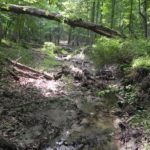
Many hollows and ravines characterize Faulkes Heritage Woods.
Faulkes Heritage Woods is a gorgeous 110-acre steep forest adjoining Winding Pathways. We walk there often. Huge oaks and other native trees fill its wondrous spaces. Wildflowers abound, especially in the spring, and birding is excellent for woodland species. Pileated woodpeckers are common.
A looping footpath starts and ends at a trailhead off Tama Street Southeast. Visitors can park along the street and enjoy the woods. But, they don’t have to stick to the trail that only covers a small area. Walkers are welcome to go off trail and scramble through the woods to enjoy its beauty and solitude.
For information:
Marion Parks and Recreation: (319)447-3580
Iowa Natural Heritage Foundation: (515)288-1846
Winding Pathways LLC.
by Winding Pathways | Oct 8, 2020 | (Sub)Urban Homesteading, Birds, Garden/Yard, Nature
The August 10 derecho changed Cedar Rapids, and Winding Pathways wasn’t spared. We lost 47 of our 53 large trees during the 40-minute windstorm. It greatly altered our restoration plans. Here’s what we did or plan to do in response to the loss of trees.
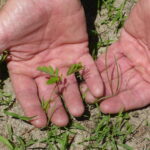
Prairie plant
New prairie plot: We planted this in early May. As expected, we only saw a glimpse of prairie plants in its first growing season, although early prairie plants give us promise that many more will appear next year. We will try to burn it either this fall or early next spring.
The derecho helped the prairie by felling or breaking four Douglas firs, one black oak, and one green ash. Two of these trees cast some morning shade on the prairie. The rest shaded it some in the late afternoon. They’re gone, so the site will enjoy more sunshine, and prairie loves sun. We mourned the tree loss but the prairie will benefit.
The trees didn’t go easily. Several tumbled into the prairie. They were big and filled with branches, leaves, and needles. We prioritized removing them. Many chainsaw and brush hauling hours later we had the trees moved into a big brush pile in the back. The sun now shines on the prairie planting. We’ll keep you posted.
-
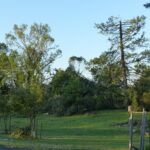
-
The firs and oak smothered the emerging prairie.
-
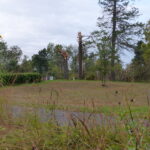
-
The firs shaded the prairie. Now more sun will shine.
Derecho Creates Opportunity
After we cleared fallen trees from the prairie, we turned to many trees that tumbled down on the north and east ends of our land. It’s taken hours to cut shattered trees and cut pathways through fallen logs so we can walk our own land easily. This land was once shady. Now the sun hits the ground. The storm transitioned the land from dense forest to savanna – a landscape of occasional trees and rich plant growth hugging the ground. Wildlife will transition as the habitat changes. Because of this change in the forest, some bird species may decline temporarily and others will thrive.
Open woodland birds: Robins, cardinals, white-eyed vireos, flickers, and Downey, red-bellied, and red-headed woodpeckers.
Mature forest birds: Scarlet tanagers, ovenbirds, wood thrushes, and pileated and hairy woodpeckers.
Shade and Sunshine
We didn’t lose all our forest trees. Just most of them. The loss of shade creates opportunities for ground-hugging plants to thrive, including baby trees. We’re already found some tiny black raspberry plants growing and many oak and hackberry seedlings.
To make sure that appropriate native savanna plants establish in the now sunny areas we ordered a native seed mix from Pheasants Forever that we’ll plant this fall.
We will keep you posted on changes in our prairies and new savanna.
by Winding Pathways | Feb 13, 2020 | Birds, Mammals, Nature
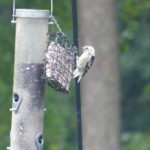
This Albino Woodpecker comes to the feeder regularly.
Several months ago, we looked out our dining room window and saw an unusual woodpecker enjoying suet at a feeder only a few feet away. It was a downy but it’s head was almost completely white, unlike all others of the same species we’ve seen.
Last year we had a fox squirrel with an unusually short tail that hung around our yard for months. We’ve also spotted other wild animals with distinctive markings unusual for their species, healed but visible wounds and other characteristics that help identify it as an individual.
The Power of Observation
Being able to identify an individual animal adds to the fun of wildlife observation. For example, from the squirrel, we learned that he or she mostly just stayed in our yard and nearby woods. We never spotted it at a neighbor’s yard. Then, one day we remarked, “We haven’t seen’ shorty tail’ for a while”. We actually never saw the animal again and assumed he or she met his end due to an accident, predator, car collision, or some other catastrophic incident. Because we could tell him from other squirrels, we know he lived at least ten months.
The piebald woodpecker still comes to our feeder, and we’re getting to know it as an individual rather than just a generic downy. It adds to the fun of wildlife observation.
Like people, animals are individuals. At first glance, every one may look the same but with careful observation, it’s possible to spot differences in plumage, fur, size, shape, gait, and even personality that help identify it as an individual. Scientists studying animals ranging from whales to snow leopards often learn to distinguish one from another by the pattern of barnacles on a whale’s body to the markings on a cat’s fur.
It’s a totally noninvasive way of distinguishing one from another. We can do this with common yard wild animals.
Do Squirrels Ever Fall?
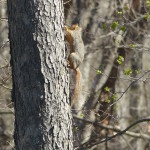
What happens when a squirrel falls?
Squirrels are amazingly agile, but they do slip and fall. It’s not common, but it happens. Rich has seen two squirrels fall from the top of large oak trees.
One squirrel lost its footing on a huge oak tree at the Indian Creek Nature Center when Rich was walking nearby. It spread out its legs and tail and fell horizontally, hitting the ground with a “thump”. Although it fell at least 40 feet the squirrel appeared uninjured, scampered off, and climbed right back up the oak.
Another squirrel fell from an even bigger oak in our home’s backyard. It did the same as the Nature Center Squirrel and spread out its body, hit the ground, and ran right off.
Squirrels rarely fall, but once in a while, they do. Fortunately, as this YouTube video shows, they seem amazingly able to recover from a fall that would instantly kill a human.
What are some of the animals you know as individuals? Let us know!
by Winding Pathways | Jun 7, 2018 | (Sub)Urban Homesteading, Birds, Garden/Yard, Nature
Birding in our Back Yard
We’ve traveled throughout the United States seeking interesting birds, and we just discovered the very best place.
It’s our backyard! Since we began actively diversifying the plants in our yard they’ve welcomed many new bird species to visit, rest, and eat. And, we live next to Faulke’s Heritage Woods, a 110 acres of shrubs and old trees that is a warbler and woodpecker haven.
Anyone who plants an array of bushes and grasses in their yard, even if it’s a tiny yard, can enjoy birding at home. Planting appropriate shrubs, mainly native species is important because some shrubs like barberry are invasive and crowd out beneficial plants.
Because the yard is right out the door, it is an easy place to grab the binoculars and a glass of wine or cup of tea and sit quietly.
Here’s what we’ve seen or heard in our yard in the past two weeks:
The winter birds left quietly – juncos and siskins. And, on their heels arrived the migrants.
Resident and Migratory Birds
Warblers: Black-Throated Green, Tennessee, Blackpoll, Cerulean, Yellow, Yellow-Rumped, and Redstart
Woodpeckers: Pileated, Hairy, Downy, Red Bellied, Red Headed, and Flicker. Earlier in the year, we saw the telltale evidence of the elusive sapsucker – wells drilled horizontally in sap filled trees.
Others: Bluebird, Cowbird, White Crowned and White Throated Sparrow, Chipping Sparrow, House Sparrow, Starling, Turkey, Crows, Vulture, Cooper’s Hawk, Barred and Horned Owls, Eagles, Chickadee, Nuthatch, Brown Creeper, House Wren, Titmouse, Goldfinch, House Finch, Robin, Wild Turkey, Hummingbird, Oriole, Rose-breasted Grosbeak, Indigo Bunting and a Wood Duck winging overhead. Additionally, Canada geese and pelicans have flown over on their way to ponds and lakes.
Recently Rich and a friend hiked to Hanging Rock in Effigy Mounds National Monument in northeast Iowa. They birded on the seven-mile walk. It was outstanding and spotted many species. But, not as many as we’ve seen sitting in our own backyard!
Winding Pathways encourages people to diversify the plants in their yards to create truly wondrous places that birds love. It can be the best place in the world to enjoy them.
-
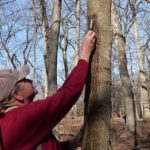
-
Rich points to horizontal holes of sapsucker.
-
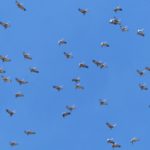
-
Winging Overhead.
-
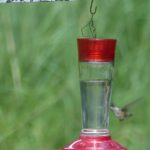
-
Getting nectar.
-
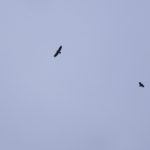
-
Two eagles in sky
-
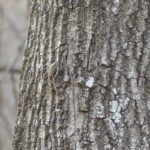
-
A camouflaged creeper on tree trunk.
-
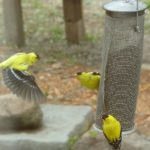
-
Iowa’s state bird
-
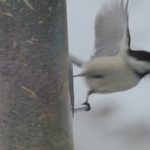
-
The cheerful denizens of open woods.
-
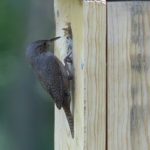
-
Checking out a birdhouse
-
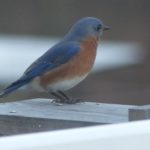
-
Male bluebird.
-
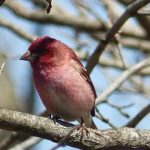
-
On a branch






























